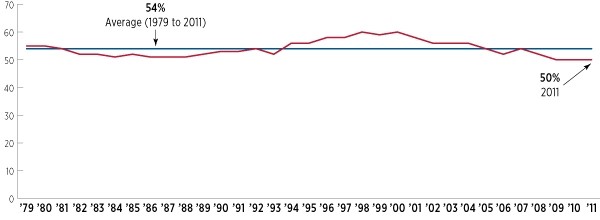
News Release
Americans Likely to Be Focused on Retirement Savings Have Access to Employer-Provided Plans
Study Illustrates Link Between Savings Goals and Access to Retirement Plans
Washington, DC, September 26, 2012 - Most workers who are likely to be focused on retirement savings have access to an employer-provided retirement plan, according to an updated study released today by the Investment Company Institute. In 2011, nearly three-quarters of workers most likely to be focused on saving for retirement had access to a retirement plan—including defined benefit and defined contribution plans—through their own employer or their spouse’s employer, and 93 percent of those with access participated.
Study Illustrates Link Between Savings Goals and Access to Retirement Plans
The study, Who Gets Retirement Plans and Why, 2011, finds a link between the savings goals of employees and the likelihood that they work for an employer who sponsors a retirement plan. When asked the primary reason they save, younger and lower-income households are typically focused on saving to fund education, to purchase a house, to fund other purchases, or to have emergency cash on hand. They are less likely to cite retirement as the primary reason they save. In contrast, older and higher-earning workers are more likely to save primarily for retirement. Consistent with these savings preferences, groups of workers who are more focused on saving for retirement are also much more likely to work for an employer that offers a plan.
Link Between Savings Goals and Retirement Plan Coverage
Percentage of private-sector wage and salary workers with access to employer-sponsored retirement plans, 2011

*“Workers likely to be focused on saving for retirement” are defined as full-time, full-year workers who (a) are aged 30 to 44 and have annual earnings equal to the median earnings for full-time, full-year workers aged 35 to 44 ($45,000) or more, or (b) are aged 45 to 64 and have annual earnings equal to the 20th percentile of annual earnings for full-time, full-year workers aged 35 to 44 ($25,750) or more.
Source: ICI tabulations of March 2012 Current Population Survey
As the chart shows, among all private-sector wage and salary workers aged 21 to 64, 50 percent work for an employer that sponsors a retirement plan. Among full-time, full-year workers aged 30 to 64, employer sponsorship increases to 60 percent. If the analysis is narrowed further to those groups of workers most likely to be focused on saving for retirement—workers aged 30 and older with at least moderate levels of earnings, and all but the lowest earning workers aged 45 and older—then 69 percent work for an employer that sponsors a plan and 74 percent have access to a retirement plan through either their own employer or their spouse’s employer. The 93 percent participation rate among those within this group with access to a retirement plan further demonstrates their interest in retirement savings.
“Policy discussions surrounding retirement often focus on the headline statistic that about 50 percent of America’s workers are covered by a workplace retirement plan,” said Peter Brady, ICI senior economist and a coauthor of the study. “This study shows that older, full-time workers are much more likely to have access to an employer-sponsored retirement plan. So, looking at the percentage of all workers who have coverage today understates the share of the population who will reach retirement having accrued employer-provided retirement benefits. Young workers don’t remain young throughout their entire working career and many part-time workers don’t remain part-time throughout their entire working career. Many workers who do not have access to an employer plan today will have access prior to retirement.”
Retirement Plan Coverage Held Steady in 2011
As part of the update to the study, ICI also released updated supplemental tables, which provide extensive additional detail on pension coverage from 1979 to 2011. These data show that the portion of private-sector wage and salary workers aged 21 to 64 working for employers that sponsored retirement plans remained stable at 50 percent in 2011. Since 1979, private-sector retirement coverage has averaged 54 percent. The coverage rate fell below its historical average in 2008 and has held steady at 50 percent since 2009.
Share of Private-Sector Workers Covered by an Employer Plan Held Steady in 2011
Percentage of private-sector wage and salary workers aged 21 to 64 at employers sponsoring retirement plans, 1979–2011

Source: ICI tabulations of March Current Population Surveys
Brady coauthored the study with ICI associate economist Michael Bogdan. The data analyzed are from the U.S. Census Bureau and U.S. Bureau of Labor Statistics’ March 2012 Current Population Survey.
